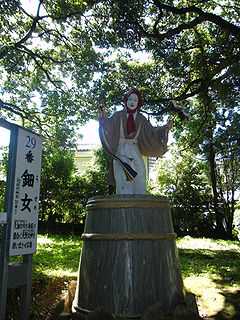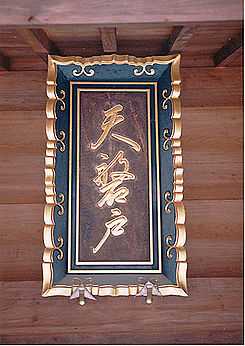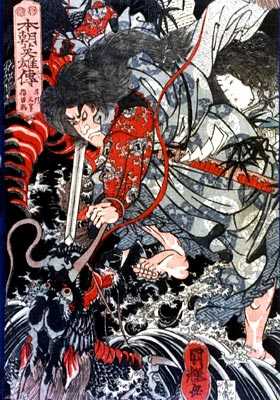Ame-no-Uzume-no-Mikoto
| Part of a series on |
| Shinto |
|---|
 |
| Practices and beliefs |
| Shinto shrines |
|
| Notable Kami |
| Important literature |
| See also |
|
| Shinto portal |


Ame-no-Uzume-no-mikoto (天宇受売命, 天鈿女命) is the goddess of dawn, mirth and revelry in the Shinto religion of Japan, and the wife of fellow-god Sarutahiko Ōkami. She famously relates to the tale of the missing sun deity, Amaterasu Omikami. Her name can also be pronounced as Ama-no-Uzume.[1][2]
Amaterasu's brother, the storm god Susano'o, had vandalized her rice fields, threw a flayed horse at her loom, and brutally killed one of her maidens due to a quarrel between them. In turn, Amaterasu became furious with him and retreated into the Heavenly Rock Cave, Amano-Iwato. The world, without the illumination of the sun, became dark and the gods could not lure Amaterasu out of her hiding place.
The clever Uzume overturned a tub near the cave entrance and began a dance on it, tearing off her clothing in front of the other deities. They considered this so comical that they laughed heartily at the sight.[3] This dance is said to have founded the Japanese ritual dance, Kagura. [4]
Amaterasu heard them, and peered out to see what all the fuss was about. When she opened the cave, she saw her glorious reflection in a mirror which Uzume had placed on a tree, and slowly emerged from her hiding spot.
At that moment, the god Ame-no-Tajikarawo-no-mikoto dashed forth and closed the cave behind her, refusing to budge so that she could no longer retreat. Another god tied a magic shimenawa across the entrance.[5] The deities Ame-no-Koyane-no-mikoto and Ame-no-Futodama-no-mikoto then asked Amaterasu to rejoin the divine. She agreed, and light was restored to the earth.
Ame-no-Uzume-no-Mikoto is still worshiped today as a Shinto kami, spirits indigenous to Japan.[6] She is also known as Ame-no-Uzume-no-Mikoto, The Great Persuader, and The Heavenly Alarming Female.[7] She is depicted in kyōgen farce as Okame, a woman who revels in her sensuality.
See also
| Wikimedia Commons has media related to Ame-no-Uzume-no-Mikoto. |
- Music, Ame-no-Uzume Op.4 (1980) composed by Hiroaki Zakōji
References
- ↑ "Treasures of the Morikami". Morikami Museum and Japanese Gardens. Retrieved 23 August 2012.
- ↑ "Iwato". Hamada City. Retrieved 23 August 2012.
- ↑ Frédéric, Louis (2002). Japan Encyclopedia. Harvard University Press. pp. 27–28. ISBN 0-674-00770-0.
- ↑ Lancashire, Terence (2004). "From Spirit Possession to Ritual Theatre: A Potential Scenario for the Development of Japanese Kagura". The Yearbook for Traditional Music (International Council for Traditional Music) 36. ISSN 0740-1558. Retrieved 23 August 2012.
- ↑ Addiss, Stephen; Groemer, Gerald; Rimer, Thomas, ed. (2006). Traditional Japanese Arts And Culture: An Illustrated Sourcebook. University of Hawai'i Press. pp. 16–17. ISBN 978-0-8248-2878-3.
- ↑ "Tsubaki Sukeikai" (PDF). Tsubaki Grand Shrine of America. Retrieved 23 August 2012.
- ↑ Herbert, Jean (2011). Shinto: At the Fountainhead of Japan. Taylor & Francis. p. 264. ISBN 0-203-84216-2.
Littleton, C. Scott (2002). Mythology: The Illustrated Anthology of World Myth and Storytelling. London: Duncan Baird Publishers. pp. 464–467.
External links
- A substantial article on this subject
- Amaterasu and Uzume, Goddesses of Japan, at Goddess Gift
- A one-paragraph glossary entry in Italian
| |||||||||||||||||||||||||||||||||||||||||||||

